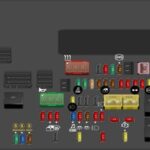The oil pressure sensor in a Caterpillar C15 engine plays a crucial role in maintaining optimal engine performance and preventing catastrophic damage. A malfunctioning sensor can lead to inaccurate readings, potentially causing oil starvation or overpressure. This article will delve into the importance of the oil pressure sensor in a Cat C15, common issues, troubleshooting steps, and replacement procedures.
Understanding the Cat C15 Oil Pressure Sensor’s Importance
The oil pressure sensor is a critical component that monitors the oil pressure within the engine’s lubrication system. It transmits this information to the Engine Control Module (ECM), which uses the data to regulate oil flow and alert the operator of any potential problems. Consistent and accurate oil pressure is vital for:
- Engine Lubrication: Sufficient oil pressure ensures all moving parts receive adequate lubrication, reducing friction and wear.
- Cooling: Oil helps dissipate heat generated by the engine, preventing overheating.
- Hydraulic System Operation: Certain engine components, such as the fuel injectors and valve actuators, rely on oil pressure for proper operation.
Common Oil Pressure Sensor Problems in a Cat C15
Several issues can arise with the oil pressure sensor in a Cat C15:
- Sensor Failure: The sensor itself can fail due to age, wear, or exposure to extreme temperatures. This can result in inaccurate readings or no readings at all.
- Wiring Issues: Damaged or corroded wiring connecting the sensor to the ECM can disrupt signal transmission.
- Low Oil Level: Insufficient oil in the engine can cause low oil pressure readings, even if the sensor is functioning correctly.
- Faulty Oil Pump: A malfunctioning oil pump can fail to generate adequate pressure, leading to low readings.
Troubleshooting the Oil Pressure Sensor
Before replacing the oil pressure sensor, it’s crucial to troubleshoot the system to pinpoint the root cause of the problem. Here’s a step-by-step guide:
- Check Oil Level: Ensure the engine oil level is within the recommended range.
- Visual Inspection: Inspect the sensor and wiring for any visible damage, such as cracks, corrosion, or loose connections.
- Gauge Verification: Compare the reading on the oil pressure gauge with the sensor’s output using a diagnostic tool. A significant discrepancy indicates a potential sensor problem.
- Wiring Test: Use a multimeter to test the continuity of the wiring between the sensor and the ECM.
- Sensor Testing: If wiring and oil levels are normal, test the sensor itself using a pressure gauge and comparing it to the manufacturer’s specifications.
Replacing the Oil Pressure Sensor
If troubleshooting confirms a faulty sensor, replacement is necessary. Follow these general steps (always consult your engine’s service manual for specific instructions):
- Locate the Sensor: The oil pressure sensor is typically located on the engine block near the oil filter housing.
- Disconnect Wiring: Carefully disconnect the electrical connector from the sensor.
- Remove the Sensor: Use a suitable wrench to remove the sensor from the engine block.
- Install New Sensor: Install the new sensor with a new sealing washer or o-ring, tightening it to the manufacturer’s specified torque.
- Reconnect Wiring: Reconnect the electrical connector.
- Verify Operation: Start the engine and check for leaks and accurate oil pressure readings.
Conclusion
The oil pressure sensor is a vital component of the Cat C15 engine. Regular maintenance, timely troubleshooting, and prompt sensor replacement are crucial to prevent engine damage and ensure optimal performance. Addressing oil pressure sensor issues promptly helps maintain the longevity and reliability of your Cat C15 engine.
